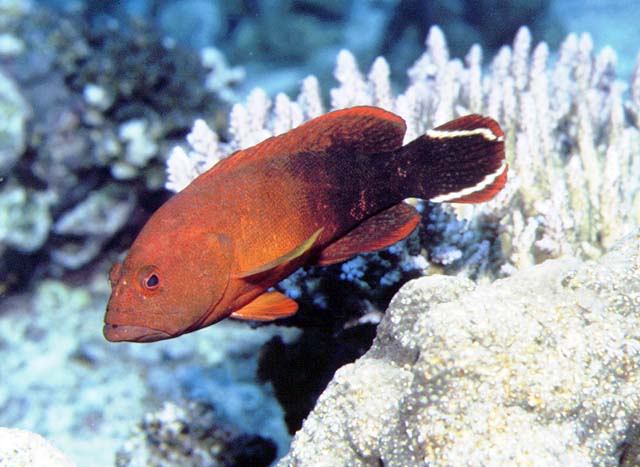| Epinephelidae (Groupers) |
| 28 cm TL (male/unsexed) |
|
reef-associated; marine; depth range 0 - 60 m |
| Pacific Ocean: eastward to French Polynesia and the Pitcairn Islands, and to Christmas Isalnd in the Indian Ocean |
|
Dorsal spines (total): 9-9; Dorsal soft rays (total): 14-16; Anal spines: 3-3; Anal soft rays: 8-9. This species is distinguished by the following characteristics: greatest body depth 2.7-3.1 in standard length; body scales ctenoid except cycloid scales ventrally on abdomen; rounded caudal fin; pelvic fins usually not reaching the anus, 1.8-2.2 in head length Colour of body reddish brown anteriorly, dark brown posteriorly; caudal fin with 2 white to bluish white bands that converge posteriorly (Ref. 90102). |
| Adults inhabit clear, shallow waters of outer reef areas, in lagoons, back-reef areas, and on the reef-top. As solitary individuals (Ref. 90102), they prefer healthy coral reef in shallow areas, and are therefore greatly affected by reef degradation (Ref. 89707). They feed on small fishes (68%) and crustaceans. Because of its small size, the darkfin hind is not of much interest as a food fish (except perhaps to subsistence fisheries), but it does well in an aquarium and may find a market as an aquarium fish. They are caught with hook-and-line, gill nets, and in traps (Ref. 39231). Minimum depth reported taken from Ref. 128797. |
|
Least Concern (LC); Date assessed: 15 November 2016 Ref. (130435)
|
| harmless |
|
Museum: AMS I.25110-020 (Coral Sea); NTM S.11375-007 (Western Australia). Known from Rowley Shoals to Claremont, Western Australia and Escape Reef to Cardwell, Queensland (Ref. 7300). Reported from the Territory of Ashmore and Cartier Islands (Ref. 75154). Also Ref. 4787, 5222, 33390, 48635, 090102. |
Source and more info: www.fishbase.org. For personal, classroom, and other internal use only. Not for publication.

